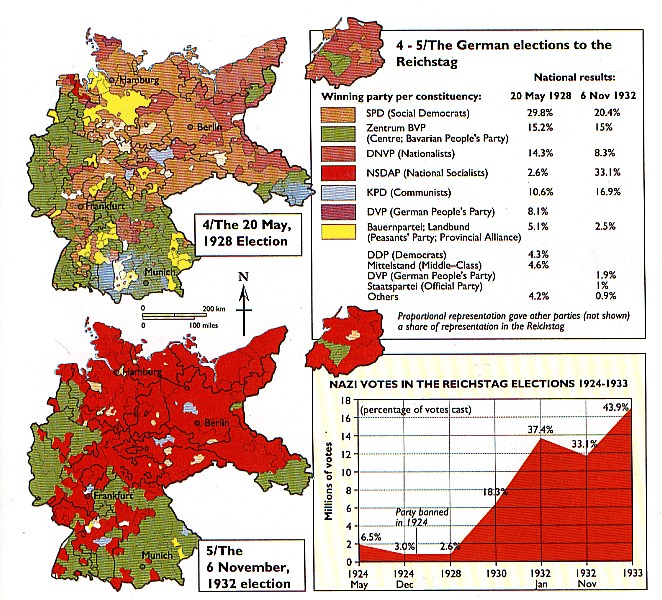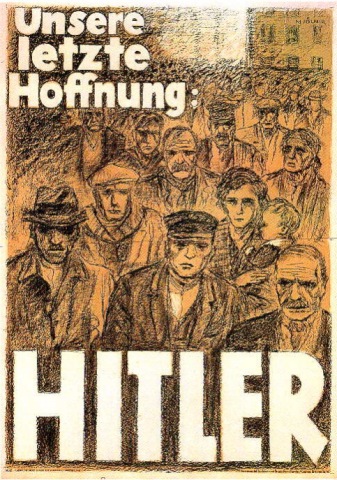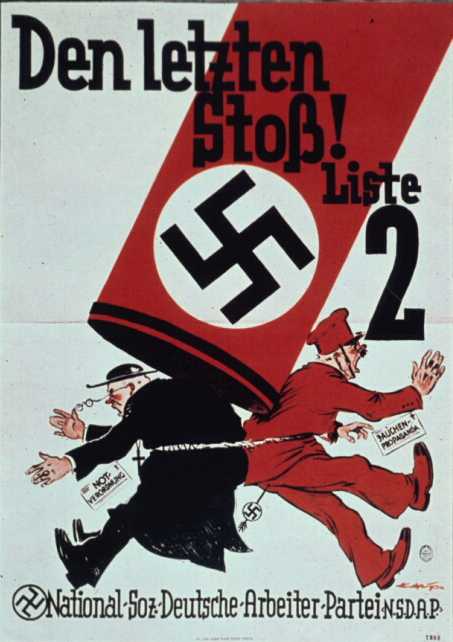|
Who Became a National Socialist? Who Voted for Hitler?
To find out what sort of person voted for the NSDAP or who joined the
party is not as easy a task as it might seem. Problems begin with the distinction
between voter and party member: the two groups overlapped, of course, but
they were not identical. The two groups present very different methodological
problems as well. The social characteristics of party members, for example,
can be established with far greater specificity than is possible with voting
constituencies. For information about party members, one can use the NSDAP's
own membership, which are housed in the Berlin Document Center. But balloting
in pre-1933 Germany was secret, so for information on Nazi party voters
one
must deduce their social and cultural characteristics from comparisons
between election results and the make-up of localities that produced them. |
|

Starting with the big picture, several obvious patterns emerge. One
is a relationship between region, religion, and National Socialism. The
map at the right compares Reichstag election returns from 20 May
1928 and 6 November 1932, broken down by administrative district. A comparison
between the results of these two elections reveals that certain regions
in the west and south were highly resistant to Nazi inroads; these regions
were predominantly Roman Catholic by religion, strongholds of the Center
Party (or Zentrum). In the Reichstag elections of July 1932,
42% of German Catholics voted Zentrum or the Bavarian People's Party
(its sister-party in Bavaria). This points at one of the strongest correlations
in Nazi voting behavior: the NSDAP typically fared best in Protestant regions
of Germany, poorest in the Catholic parts.
Many historians argue that a similar correlation
existed between class and voting: the NSDAP performed less well in heavily
industrialized districts with large working-class populations, and this
seems to be born out by the resilience of the Social Democratic and Communist
constituencies during the period between 1928 and 1933, when the NSDAP
became the largest single party in Germany. Thus 40-45% of blue collar
workers voted for the SPD or the KPD in 1932, while only 10% of workers
voted for one of the Catholic parties. The remainder were divided among
the various bourgeois parties of the middle and right; by 1930 most of
these were voting for the NSDAP. But overall, Nazis remained a minority
among blue-collar voters. (Map source: Richard Overy, The Penguin Historical
Atlas of the Third Reich (1996), 21). |
All this suggests that the biggest shifts in voter behavior took place
within the middle classes—as the collapse of the bourgeois parties suggests
(see Reichstag Election Results, 1919-1932).
The idea in a nutshell, is that the Nazi party owed its success to a middle-class
defection from the Republic, its values and institutions. By why? Historians
have devised several theories to explain this shift.

This Nazi campaign flyer, from 1932, is directed at Communists
and offers them mutual aid and support if they abandon their party and
vote National Socialist. Source: German
Propaganda Archive. |
1) Mass Psychology:
This is the idea that Nazism's appeal was deeply psychological, rooted
in irrational fears of isolation in an atomized, industrial society. Nazism
seemed to offer a sense of purpose and community to people who lacked both.
For many Germans, according to this view, Nazism offered the promise of integration in a purposeful community,
a way out of the rootlessness of modern life. According to this hypothesis, one would expect Nazism to resonate most strongly among the least integrated
social groups, such as war veterans, unmarried youth, and victims of the
Great Depression—in other words, people among whom feelings of isolation and powerlessness were
most pronounced. By the same token, one would also expect to find that Nazism appealed least
in highly integrated communities. |
2) Middle-Class Panic:
In his classic study, The Nazi Seizure of Power,
William Sheridan Allen argued that after the Great Depression struck, middle
class Germans turned to Nazism not because they had suffered greatly but
because they feared that they might. Such concerns were especially
pronounced among the lower middle class, especially members of the “old”
middle class occupations—independent artisans and retailers, middling farmers,
employees. These were the people who were most vulnerable to the effects
of an industrialized, consumer-oriented economy, who were the most exposed
to the threat of a decline in social status, who were in the greatest danger
of descending socially into the “proletariate.” In contrast to the established middle
class parties, the NSDAP exhibited vitality and dynamism; to members of
the “old” middle class, Nazism promised a restoration of their social,
economic, and political importance. |

This poster from the November 1932 elections declares
Hitler to be “our last hope”. Source: German
Propaganda Archive. |

This Reichstag campaign poster from 1932 promises
to deliver a “final blow” to the Center Party—symbolized by a Catholic
priest—and the Marxist parties of the left. Source: German
Propaganda Archive. |
3) Political 'Confessionalism':
Why did some social groups prove so vulnerable to Nazism, while others
did not? The theory of political confessionalism draws on the 'mass psychology'
thesis to explain why certain middle-class groups were resistant to Nazism,
while others became easily frustrated with the political parties that represented
them. From the 'mass psychology' theory it borrows the idea that poorly
integrated people were especially susceptible to the NSDAP's appeals; it
adds the notion that political parties that offered strong identities and
dense social networks that 'immunized' their members against Hitler. These effects
were most pronounced among German Catholics—hence resilience of electoral districts in which the party of political Catholicism, the Zentrum, did well at the polls—and among members of the Social Democratic Party (SPD) and the
Communist Party (KPD). All of these parties provided their members far more than
ideology; they offered a rich associational life, a sense of common purpose
and distinction. |
How does the evidence stack up? To find out, go to:
1) Mass Psychology
Age of new NSDAP members, 1925-1933
Unmarried new NSDAP members,
1925-1933
Residence of new NSDAP members,
1925-1933
2) Middle-Class Panic
New NSDAP members, yearly
by class, 1920-1944
New NSDAP members, by occupational
group, 1925-1933
New NSDAP members, male and female,
by occupational group, 1925-1933
New NSDAP members, by class,
1925-1933
3) Political 'Confessionalism'
New NSDAP by confessional
context, 1925-1933
Social composition of the NSDAP,
1942
A Final Note: Women
and National Socialism
Voting Behavior According
to the Sex of the Voter
Percentage of
Women's and Men's Vote for the Hitler/NSDAP
Bibliography:
William Sheridan Allen, The Nazi Seizure
of Power: The Experience of a Single German Town, 1922-1945, 2d ed.
(New York: Watts, 1984).
Thomas Childers, The Nazi Voter: The
Social Foundations of Fascism in Germany, 1919-1933 (Chapel Hill: University
of North Carolina Press, 1983)
——, “Who, Indeed, Did Vote for Hitler?,”
Central
European History 17 (1984): 45-53.
——, ed., The Formation of the Nazi Constituency,
1919-1933 (Totowa: Barnes & Noble, 1986).
Jürgen W. Falter, Hitlers Wähler
(Munich: Beck, 1991).
——, “Wer wurde Nationalsozialist?: Eine Überprüfung
von Theorien über die Massenbasis des Nationalsozialismus anhand neuer
Datensätze zur NSDAP-Mitgliedschaft 1925-1933,” in Helge Grabitz et
al., Die Normalität des Verbrechens: Bilanz und Perspektiven der
Forschung zu den nationalsozialistischen Gewaltverbrechen (Berlin:
Edition Hentrich, 1994), 20-41.
——, “The Social Bases of Political Cleavages
in the Weimar Republic, 1919-1933,” in Larry Jones and James Retallack,
eds., Elections, Mass Politics, and Social Change in Modern Germany:
New Perspectives (Cambridge: Cambridge University Press, 1992).
Johnpeter Horst Grill, THe Nazi Movement
in Baden, 1920-1945 (Chapell Hill: University of North Carolina Press,
1983).
Richard F. Hamilton, Who Voted For Hitler?
(Princeton: Princeton University Press, 1982).
——, “Braunschweig 1932: Further Evidence
on the Support for National Socialism,” Central European History
17 (1984): 3-36.
Oded Heilbronner, Catholicism, Political
Culture, and the Countryside: A Social History of the Nazi Party in South
Germany (Ann Arbor: University of Michigan Press, 1998).
Michael Kater, The Nazi Party: A Social
Profile of Members and Leaders, 1919-1945 (Cambridge: Harvard University
Press, 1983).
Detlef Mühlberger, Hitler's Followers:
Studies in the Sociology of the Nazi Movement (London: Routledge, 1991).
Helena Waddy-Lepovitz, “Beyond Statistics
to Microhistory: The Role of Migration and Kinship in the Making of the
Nazi Constituency,” German History 19 (2001): 340-368.
Return to
443/543 Homepage



